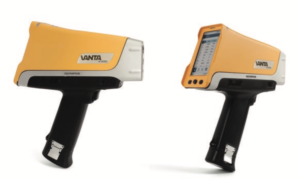07 Feb Integration of the Olympus Vanta
Geotek’s X-ray fluorescence (XRF) sensor range has gained the latest high performance handheld spectrometer, the Olympus Vanta, which over the next 12 months will replace the popular Olympus DELTA model on Geotek core logging systems.
The Vanta XRF analyser is a significant upgrade to the Olympus Delta with superior speed of measurement, decreased processing time, improved limits of detection (even for low energy elements such as Mg, Si, Al). In addition, Geotek are now offering our customers the choice of two handheld XRF Vanta models: the M series and the C series. The standard C series (VCR) is equipped with a silicon drift detector, a 40 kV X-ray tube, and a rhodium (Rh) anode; whereas the M series (VMR) comes equipped with a sensitive large area silicon drift detector and a 50 kV X-ray tube again with a Rh anode.

The new Olympus Vanta XRF analyser
Geotek have integrated handheld XRF spectrometers onto our Multi-Sensor Core Logger systems (MSCL) for the past 10 years. An MSCL is capable of simultaneously acquiring physical properties (such as density or magnetic susceptibility) and other geochemical parameters (such as natural gamma or VNIR/SWIR Hyperspectral data) in addition to the Vanta’s XRF data. This makes an MSCL equipped with an Olympus Vanta a great fit for oil and gas chemostratigraphy studies, or mineral exploration.
MSCL systems offer a stable and repeatable measurement geometry where the triggering of the analyser is automatically controlled through software. Geotek’s custom-designed software seamlessly communicates with the Vanta XRF to provide depth co-registered XRF data during acquisition, with limited user intervention. Geotek utilises Olympus’ interpretation software and calibrations to present the acquired spectra and elemental concentration displaying the results automatically during logging, alongside other chemical or physical property datasets. These data can then be easily exported as an ascii file for presentation or further analysis.
Handheld XRF analysers mounted onto an MSCL are becoming increasingly popular for research and academic institutions; especially as an upgrade to an existing core logger. Handheld analysers are being used by our customers for paleoclimate studies (e.g. Schillereff et al., 2015), mineral exploration (e.g Ross et al., 2014), and basic geochemical logging (e.g. Nitsche et al., 2008) as a cost effective, one-scanner solution for institutions to benefit from their own XRF studies of their sediment or rock core samples.

Example XRF data collected using the Olympus handheld XRF sensor
Across our product range, there are a number of systems compatible with the Olympus Vanta. For a cost effective, space saving option, our smallest system the XZ benchtop logger would be ideal. If you are looking for a system where you can acquire physical and geochemical properties, without numerous instruments, Geotek’s MSCL-S would be most suitable. If you are looking for core box or multi-core logging for further efficiency, Geotek’s Core Workstation (MSCL-XYZ) is the right solution.
Furthermore, the Olympus Vanta can be used with an MSCL system, or removed as a field portable unit. As a field unit the new Vanta model has excellent durability, an intuitive user interface, and optional Wireless LAN and Bluetooth for real-time data sharing. The Vanta provides precise results ensuring productivity is at a maximum. Crucially, the Vanta is IP65 rated* dust and water resistant, drop tested using military standard methods, and features a detector shutter helping to prevent punctures, letting you analyse rough surfaces at ease. *Vanta M series analyzers are IP64 rated.
John Roberts Geotek’s Technical Director says “It is excellent to be continuing our relationship with Olympus. The Vanta XRF mounted onto our MSCL allows our customers to quickly and efficiently acquire quality XRF datasets on a range of core materials in an automated and controlled manner. Importantly, we can easily export the XRF data with a range of other MSCL parameters enabling geoscientists to build more complete picture of the geological stratigraphy, improve sub-sampling strategies, identify key horizons for mineral exploration and the properties of fracture infills, or identify changes in the geological record reflecting past climate.”
Todd Houlahan, Director of Olympus’ International Mining Group expands, “The partnership we have had with Geotek over the last 10 years has allowed both our companies to innovate and offer market leading solutions to the academic, oil and gas and mining industries. The dual purpose available to customers to use our XRF’s on Geotek’s core logging systems and as a handheld has been very popular and we look forward to the next 10 years of collaboration.”
Olympus is a leader in XRF technology with a reputation for quality and accuracy. The Olympus International Mining Group (IMG) is an internal group of natural resource specialists wholly focused on geochemical applications of XRF and XRD. The IMG has unparalleled expertise in utilising portable XRF technology for a range of in-field geological scenarios. Olympus’ global network of support staff provide a level of ongoing service to the customer that includes support for testing methods, special calibrations, and user training.
To learn more about the Vanta and our MSCL systems click here: Vanta and MSCL.
To keep informed with our latest news, please follow our LinkedIn.
Please don’t hesitate to contact us for advice in choosing the best system for your application.
Schillereff. D.N, Chiverrell. R. C, Croudice. I.W, and Boyle. J.F . 2015. Approaches to Water Content Correction and Calibration for µXRF Core Scanning: Comparing X-ray Scattering with Simple Regression of Elemental Concentrations. In. Croudace. I W., and Rothwell. R. G (eds.). Micro-XRF Studies of Sediment Cores Developments in Paleoenvironmental Research 17”
Ross. P. -S. , Bourke. A., and Fresia. B. 2014. Improving lithological discrimination in exploration drill-cores using portable X-ray fluorescence measurements: (1) testing three Olympus Innov-X analysers on unprepared cores. Geochemistry: Exploration, Environment, Analysis, 14, 171-185, 4 February 2014
Nitsche. F.I., Kenna. T., Haberman. M. 2010. Quantifying 20th century deposition in complex estuarine environment: An example from the Hudson River. Estuarine, Coastal and Shelf Science, 89, 163-174.

